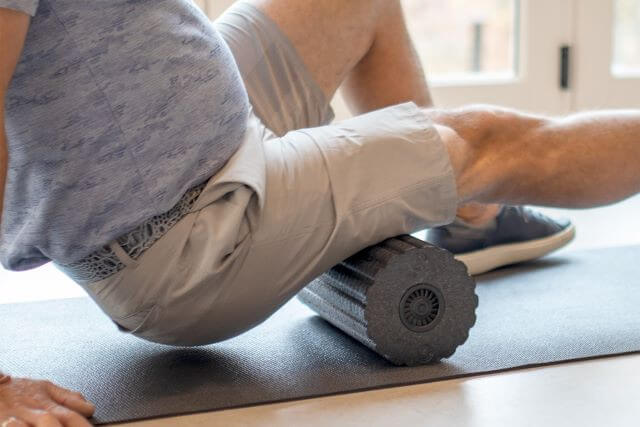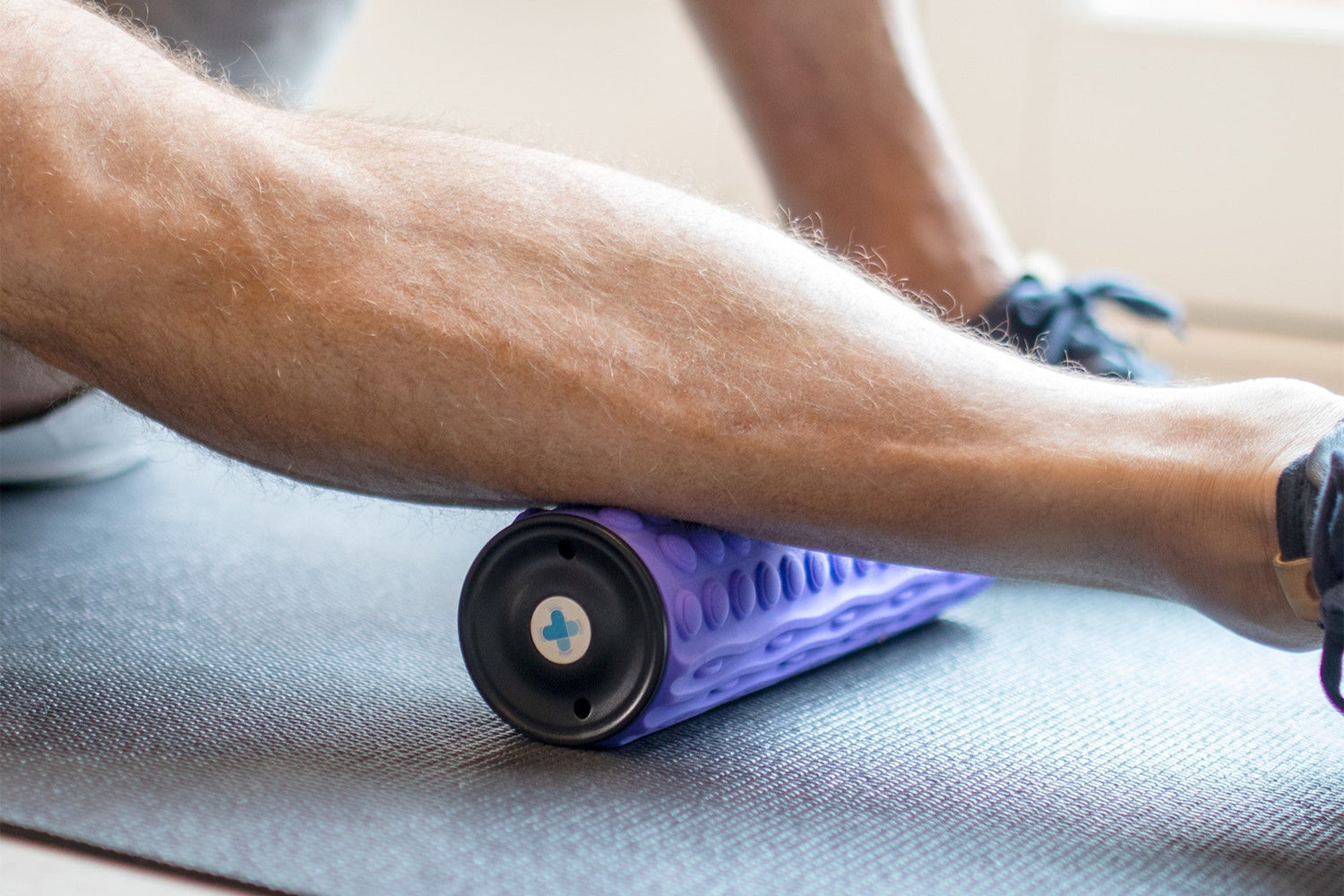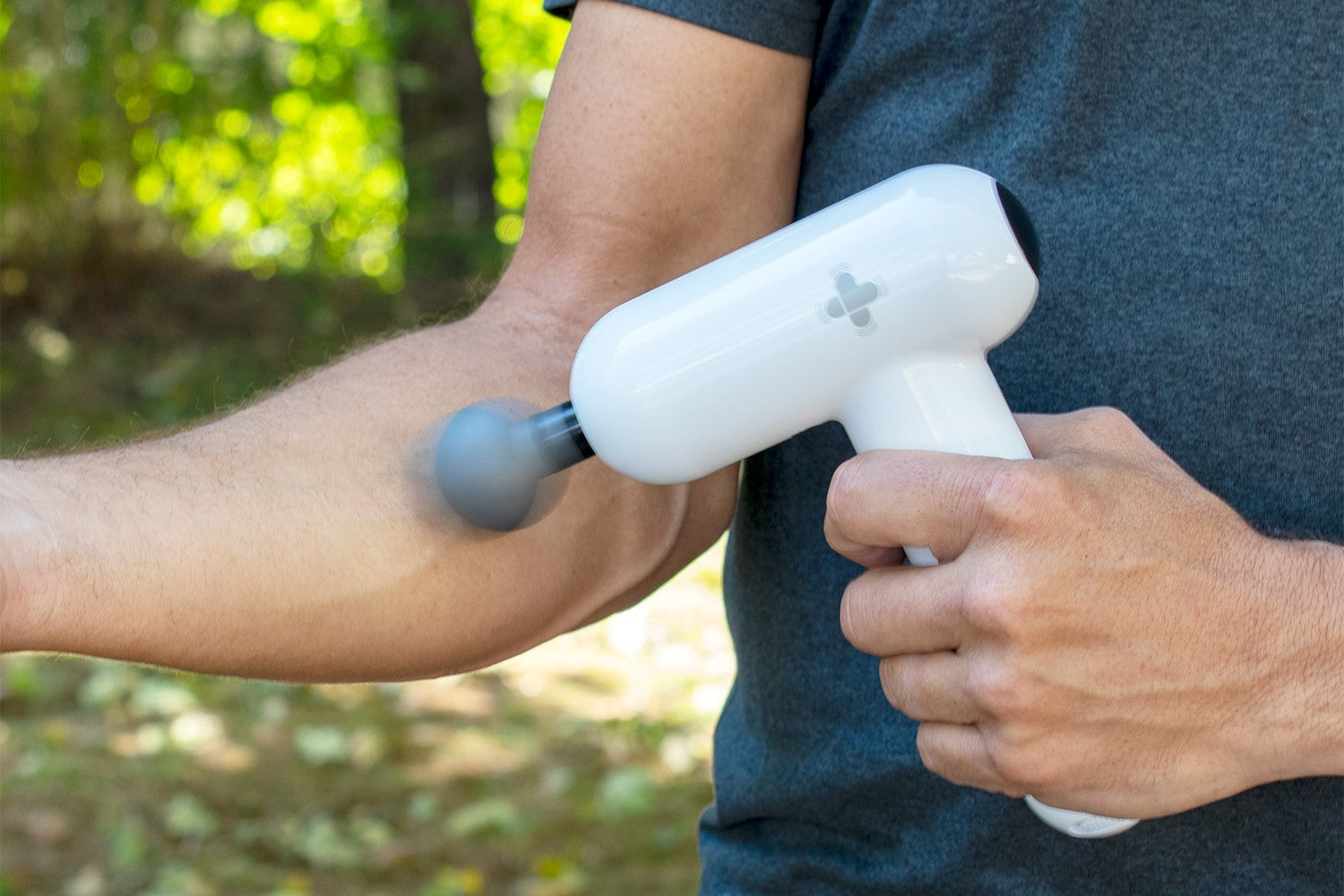You probably know that a massage can work wonders for sore, tense leg muscles. But what if you don’t own a massage gun, or you can’t visit a spa each week? Could you try foam rolling your legs instead?
Many people embrace foam rolling as a core part of their recovery routine — and for good reason. Eighty percent of orthopedic and sports physical therapy professionals report using a foam roller in their practice, and 51% recommend their clients use it too.
Whether you’re a runner, athlete, or simply have tight leg muscles, it can be worth giving these tools a try. Below, learn everything you need to know about foam rolling legs, including the dos, don’ts, and top exercises to try.
What Exactly Is Foam Rolling?
In a nutshell, foam rolling involves using a cylindrical tool to knead out tension in your muscles and fascia — aka the connective tissue throughout your body. Because it works on this connective tissue, foam rolling is also called self-myofascial release (SMR).
When you do foam rolling exercises, your nerve fibers and muscle tissue are stimulated by steady pressure. In turn, this can result in enhanced flexibility, a boost in circulation, and muscle pain relief.
What Type of Foam Roller Should You Use?
Many types of foam rollers can help you roll out stiff leg muscles, all with different sizes, textures, and densities. But as a rule of thumb, the denser your foam roller, the deeper the pressure will be.
With that in mind, is there a type of foam roller that’s better than the rest?
While there hasn’t been much research on the best types of foam rollers for legs, one 2018 study involving 36 people looked at the differences between soft, medium, and hard-density rollers.
Remarkably, the findings showed that all three options helped improve knee ROM and muscle pain. So, while some foam rollers are more advanced, nearly any type of roller you have on hand can work well.
The Benefits of Foam Rolling Legs
So, what exactly can foam rolling do for your legs? Whether you’re an athlete or simply want to boost your mobility, here are some of the top benefits to be aware of:
Relieves Muscle Stiffness
You probably know about the post-workout tension that comes with regular gym sessions. But between long days at work and lounging at home, many of us also spend several hours a day sitting — and unfortunately, it’s one of the biggest culprits behind leg stiffness.
The good news? Foam rolling is a great tool for breaking up leg tension, whether it’s from an intense workout or sitting at the office. In fact, a 2020 review of 49 studies found that foam rolling can help alleviate muscle stiffness, all while supporting overall mobility.
Improves Range of Motion
A foam rolling session isn’t just good for muscle tension relief; it can also help boost your joint range of motion (ROM). And if you stick to it long-term, you could see a notable difference in the way your body feels and moves.
Recent research from 2022 found that those who foam rolled for more than four weeks had a greater boost in hamstring and quad mobility than those who rolled for less than four weeks.
With that in mind, it’s well worth adding this practice to your long-term routine — even if you can only commit to one or two rolling sessions per week.
Warms Up Your Muscles
If you’ve been looking for ways to improve your warm-ups, foam rolling can help. Not only does it lengthen and loosen your muscles, but it can also support healthy blood flow. And when you pair it with a dynamic stretching routine, it could lead to better performance and mobility during your workouts.
Soothes Delayed Onset Muscle Soreness (DOMS)
If you live an active lifestyle, you know that a good massage is one of the best ways to melt away post-workout soreness. But when you can’t get a full massage, it turns out that foam rolling can be a great alternative.
In a small 2015 study, researchers explored what a few 20-minute foam rolling sessions could do after hamstring exercises. Eight healthy adult men participated, using the foam rollers right after exercise, the next day, and two days later.
Incredibly, the results showed that foam rolling helped improve DOMS and performance in the days after the workouts.
How to Foam Roll Legs: 5 Top Exercises

With all these benefits in mind, here are five of the top leg foam rolling exercises to stretch, soothe, and support your busy muscles:
1. Hamstring Roll
The hamstring roll is one of the most popular beginner foam rolling exercises, and for good reason.
It targets one of the largest, busiest muscle groups in the body — and when done properly, it can bring almost instant relief from pain and stiffness. Plus, it can improve your ability to move freely while walking, running, and doing certain exercises.
Here’s how to try it:
- Sit on a comfortable surface, and place the foam roller horizontally underneath your hamstrings.
- Slide your right foot up towards your body, and plant it on the ground in front of your roller. Your knee should be pointing up in the air with your left hamstring still resting on the roller.
- Place your arms out behind you for stability.
- Use your right leg and arm strength to lift your body, and begin to roll the hamstring. (Tip: Be sure to keep your glutes off the floor while you roll.)
- Roll from just below the glute down to the knee.
- Continue to roll for 1 to 2 minutes, and repeat with the other leg.
- Optional: If you’d like, you can try this exercise with both hamstrings resting on the roller.
2. Calf Roll
If you’re someone with tight, achy calves, calf foam rolling might just become a staple in your routine. To get started:
- Grab a foam roller, and sit on a comfortable surface. (Any kind of foam roller will do, but a medium-density option works well for the calves.)
- Place the foam roller under your left calf, just below the knee.
- Gently flex your foot up towards your knee. (This is called dorsiflexion, and it can help you massage your calf muscles more deeply.)
- Use your opposite foot and arms to lift your body off the ground.
- Begin to roll your calf using slow, controlled motions. Stop near your Achilles tendon, and roll back up to just below the knee.
- Roll for 1 to 2 minutes, and repeat with the other leg.
3. Basic Quads Roll
Our quads work hard in nearly every leg-focused activity we do. And unfortunately, this can make them a hotspot for stiffness and trigger points.
On top of that, because of how our quads help align our knees and pelvis, too much tension in these muscles can even lead to knee and back pain.
Luckily, this basic quad rolling exercise offers an easy way to find relief. Here are the steps:
- Lie face down, and place the foam roller horizontally under the center of your left quad muscle.
- Push your body up with your hands, and kneel out with your right leg for added stability.
- Use moderate pressure to slowly roll up and down the left quadriceps. Start above the knee and stop when you reach the top of the quad (just below the hip).
- If you find a knot or trigger point, pause and hold the pressure for an additional 10 seconds.
- Optional: As you roll, feel free to rotate your leg inward and outward to reach the quads from different angles.
- Roll for 1 to 2 minutes, and repeat with the other leg.
4. Vastus Lateralis Roll
While many people think of the quadriceps as one big muscle, it actually consists of four different muscles in the front of the thigh.
One of these muscles is the vastus lateralis, which is the strongest, biggest part of your quads. It sits towards the outside of the upper leg, and engages every time you extend or straighten your knee.
To target this busy, powerful muscle, give this foam rolling exercise a try:
- Lie sideways on the ground, and place the roller horizontally under your outer left thigh, just above the knee. Your left leg should be extended, with the edge of your foot resting on the ground — similar to being in a side plank position.
- Use your left arm to support your upper body.
- Cross your right leg over to the front of your body, planting your foot firmly on the ground for stability.
- Begin rolling the muscle upward. Pause when you reach just below the hip.
- Roll back down to the starting position, and repeat.
- After 1 to 2 minutes, flip over and roll the opposite thigh.
5. Glute and Piriformis Foam Roll
Like your quads, tight glutes can also lead to imbalances and pain in other parts of the body. Fortunately, the glute foam roll is one of the easiest, most impactful SMR exercises you can add to your recovery regimen.
Here’s how to try it:
- To start, simply sit on your foam roller. Then, cross your right leg over your left knee.
- Place your left hand out on the floor behind you for stability. Use your right hand to hold your crossed leg in place.
- Begin rolling your glute back and forth over the roller.
- Roll for 1 to 2 minutes, and repeat with the other side.
6 Essential Dos and Don’ts of Foam Rolling Legs

Foam rolling your legs can make a significant difference in your mobility and overall well-being. But before you jump into your new recovery routine, here are a few key tips to keep in mind:
Do: Be Gradual While Increasing Pressure
If you’ve never foam rolled before, you might not know how much pressure is right for you. For this reason, it’s best to start light and increase your pressure as needed. Be sure to use slow and intentional motions, and pay attention to how your muscles feel while you roll.
In addition, be mindful of any trigger points (aka knots) that you come across during your sessions. When you feel one of these points, you can pause and hold the pressure for a few extra seconds to help it release.
Do: Expect Some Discomfort While You Roll
While you foam roll, you might notice mild discomfort as you massage along your quads, hamstrings, and calves. This “hurt-so-good” type of pain is totally normal, and it happens as a result of working out the tension in sore, tight muscles.
That being said, be sure to avoid any areas that are downright painful, as it could be a sign of inflammation or injury. In these cases, it’s best to give the muscle a few days of rest before trying self-massage again.
Do: Foam Roll Your Legs Pre- or Post- Workout
A good foam rolling session can do wonders for your body both before and after exercise.
When used as a warm-up tool, it can bring a boost of blood flow and mobility to your joints. At the same time, a 5 to 15-minute post-workout session can help improve DOMS and the overall recovery process.
In other words, foam rolling is pretty versatile, so feel free to tailor your routine to match the benefits you want most.
Do: Talk to Your Doctor Before Foam Rolling an Injury
Foam rolling can be the perfect tool for mild aches and pains, but it’s not always a good fit for every injury.
For example, you’ll want to avoid rolling over acute injuries like calf strains. Plus, it’s important to watch out for any open wounds, skin conditions, or bruises.
While fairly rare, lower leg pain can also be a sign of blood clots for some people. If you have swelling, warmth, redness, or pain in your leg — especially in the calf — that seemingly came from nowhere, be sure to check with your doctor ASAP.
Don’t: Foam Roll Over Bony Areas or Joints
When you’re feeling especially sore and achy, you might have the urge to foam roll your entire body. However, it’s best not to roll your joints, bones, ligaments, and other spots without muscle and fascia.
Areas like the shins, kneecaps, and ankles don’t have a lot of soft tissue for the roller to massage, so it can be counterproductive to work on them.
Instead, you’ll reap more benefits by working on the muscle groups surrounding your joints and bones. For example, if you want to soothe an achy knee, it can help to spend some time massaging the hamstrings and quads.
Don’t: Spend Too Long on Any Muscle Group
When it comes to foam rolling legs, it’s essential not to spend too much time rolling any one area.
Typically, experts recommend spending around 60 seconds on each muscle group, and no longer than two minutes. This is because you don’t want to overdo it — especially if you’re already dealing with mild muscle soreness.
After all, the goal of foam rolling is to relax and soothe the muscles. And if you spend too much time on a spot that’s already tender, it may end up doing more harm than good.
How Often Should You Foam Roll Your Legs?
There’s no universal answer to this question — but in short, it’s best to foam roll at least semi-regularly.
While once-in-a-while foam rolling still feels great, it’s unlikely to bring any lasting changes to your leg health. However, rolling a few times per week (or up to once per day) could help you see a noticeable boost in your mobility and recovery.
The Takeaway on Foam Rolling Legs
If you’re interested in athletic self-massage, foam rolling is one of the best places to start. It can help soothe DOMS, boost mobility, and warm up your leg muscles before exercise. And best of all, it’s one of the most accessible ways to try massage at home.
That being said, getting the most out of your leg foam rolling routine works best when combined with other good fitness habits — like stretching, nutrition, and proper rest. So, as you start using this recovery tool, don’t forget about these other steps along the way.
Get Deeper Relief With Therapeutic Home Massage
Looking to bring the benefits of massage to the comfort of your home? The physician-trusted, ultra-convenient tools from MedMassager can help.
View the full range of recovery massage tools here, or learn more about the many ways they can bring relief.



